Chickens are amazing creatures. Not only do they provide us with delicious eggs, but they also offer us hours of entertainment as we watch them socialize and play in the yard. They’re relatively low-maintenance, making them the perfect pet for busy people.
But with so many different chicken breeds to choose from, it can be hard to decide which one is right for you. That’s why we’ve put together a “chick list” of the 15 best egg-laying chicken breeds to help you make an informed decision.
Read on to see more about these egg laying chicken breeds images.
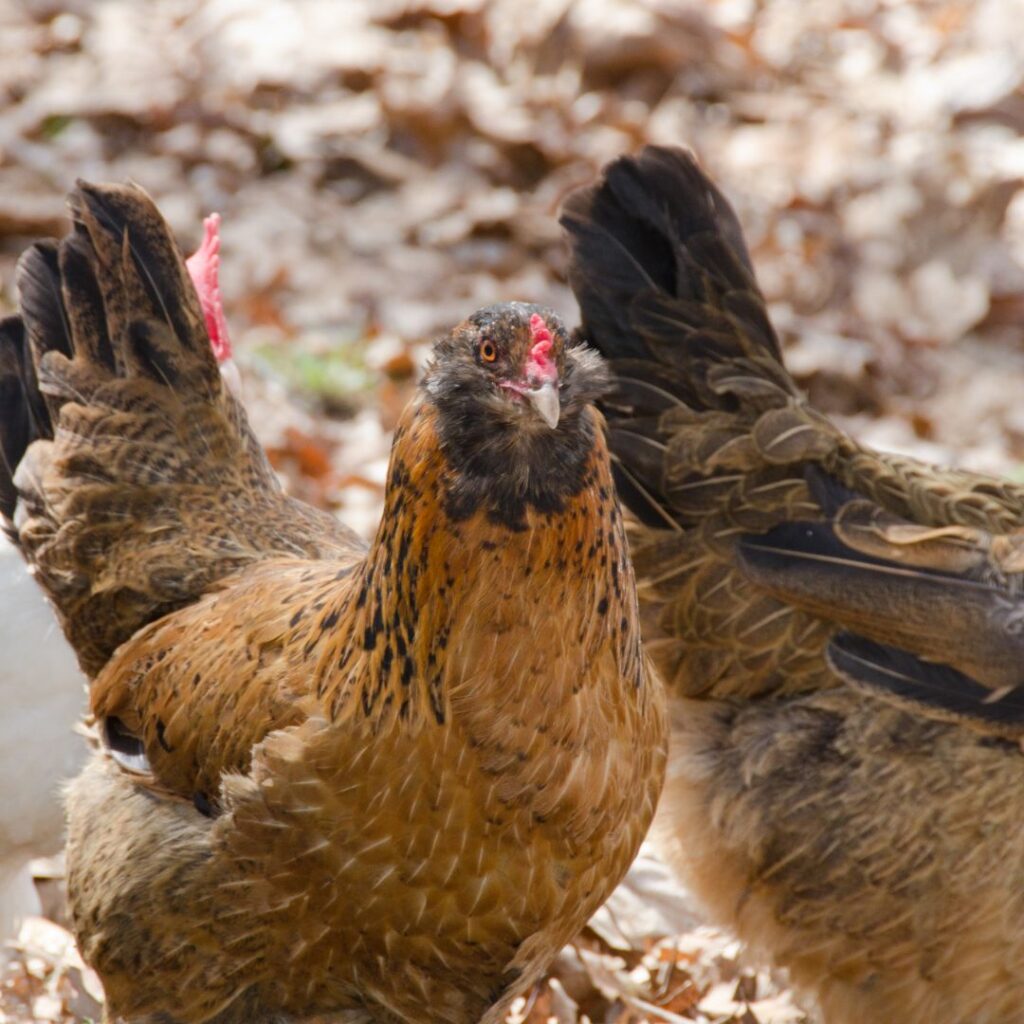
Ameraucana
Developed in the 1970s in the United States, the Ameraucana was bred from Araucana chickens from Chile to retain their signature blue egg gene without the lethal genes found in some Araucanas.
The Ameraucana has a pea comb and comes in standard and bantam sizes, with eight recognized color variations, including black, blue, wheaten, and white. These chickens also have small or absent wattles and round earlobes, with red coloring on their comb, wattles, and earlobes. Their shanks tend to be slate-blue, with black plumage variants displaying darker legs.
Egg Size – Large
Egg Color – Blue
Eggs per year – 180-200
Ancona
The Ancona chicken is a small-bodied breed that hails from the Mediterranean region. With origins in Italy’s Marche region, these chickens have been bred for their prolific egg-laying ability for centuries. Thanks to geographic isolation, the Ancona has maintained its unique qualities and continues to thrive as a poultry breed today.
Their genetics include early Leghorns, giving them a sturdy build and strong productivity.
Despite their small size, weighing in at only 4.5lbs, Ancona hens can lay large white eggs consistently throughout the year, earning their reputation as reliable layers.
The American Poultry Association recognized the Ancona in 1898 for their single comb variety and in 1914 for their rose comb variety.
The breed’s standard calls for a black base color with white mottling that forms distinct v-shaped specks and about one-fifth of feathers tipped with white. Interestingly, as the chicken ages, its mottles tend to increase in size and quantity, often referred to as “going gray.”
Egg Size – Extra Large
Egg Color-White
Eggs per year – 220
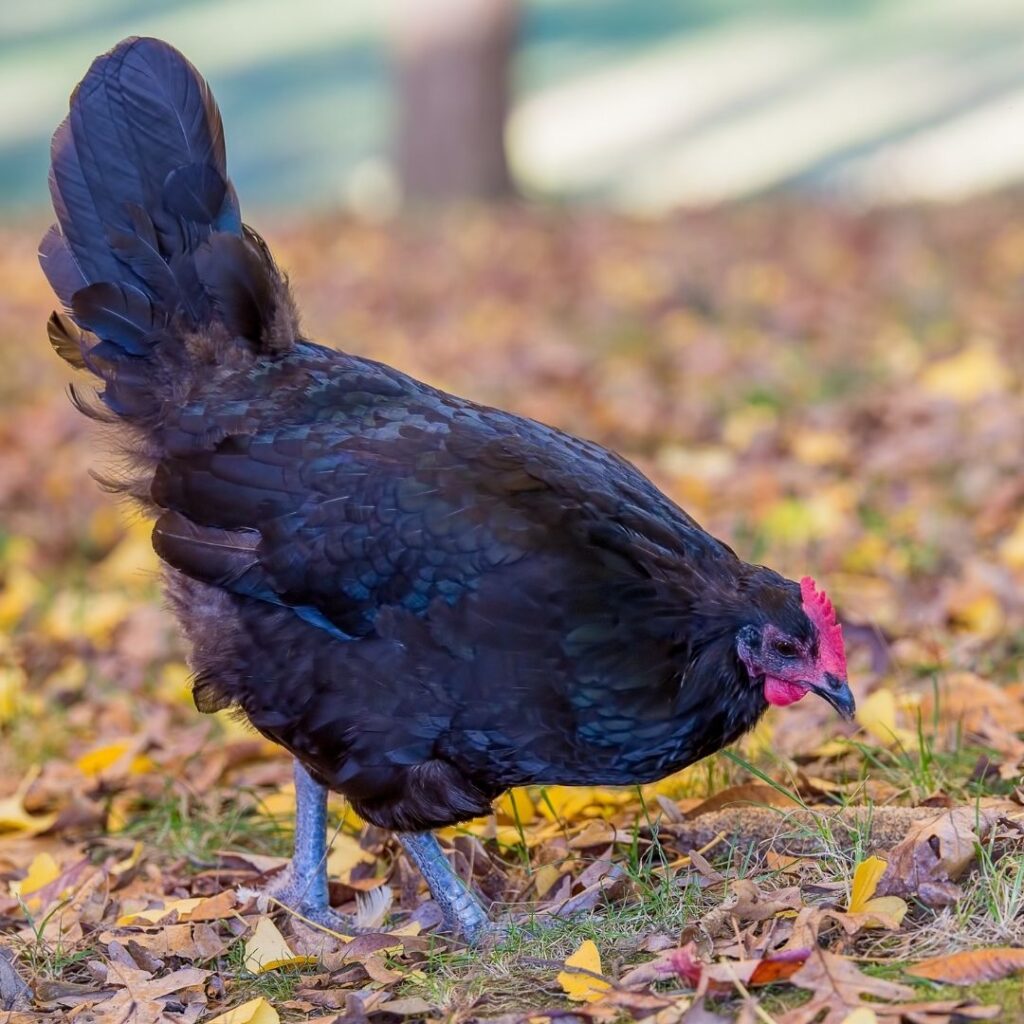
Australorp
These birds are recognized for their playful and friendly dispositions, making them excellent companions for backyard farmers and urban homesteaders. They also greet their owners enthusiastically and follow them around the coop or yard.
The Australorp is a breed of chicken bred to excel in egg-laying and meat production. Native to Australia, this breed was developed from Black Orpingtons imported from England and out-crossed with other breeds such as Minorca, White Leghorn, Langshan, and some Plymouth Rock.
In the early stages, these chickens were known as Australian Black Orpingtons before being named the Australorp we know today.
The American Poultry Association accepted this Heritage breed in 1929.
Thanks to careful breeding for utility traits, the Australorp is renowned for its high levels of egg production and robustness as a meat bird. They are also cold and heat-hardy chicken breeds. They’re known to be popular as one of the best-laying hens for Texas extreme weather. Read more about heat-tolerant chicken breeds here.
Egg Size – Large
Egg Color – Brown
Eggs per year – 200-280
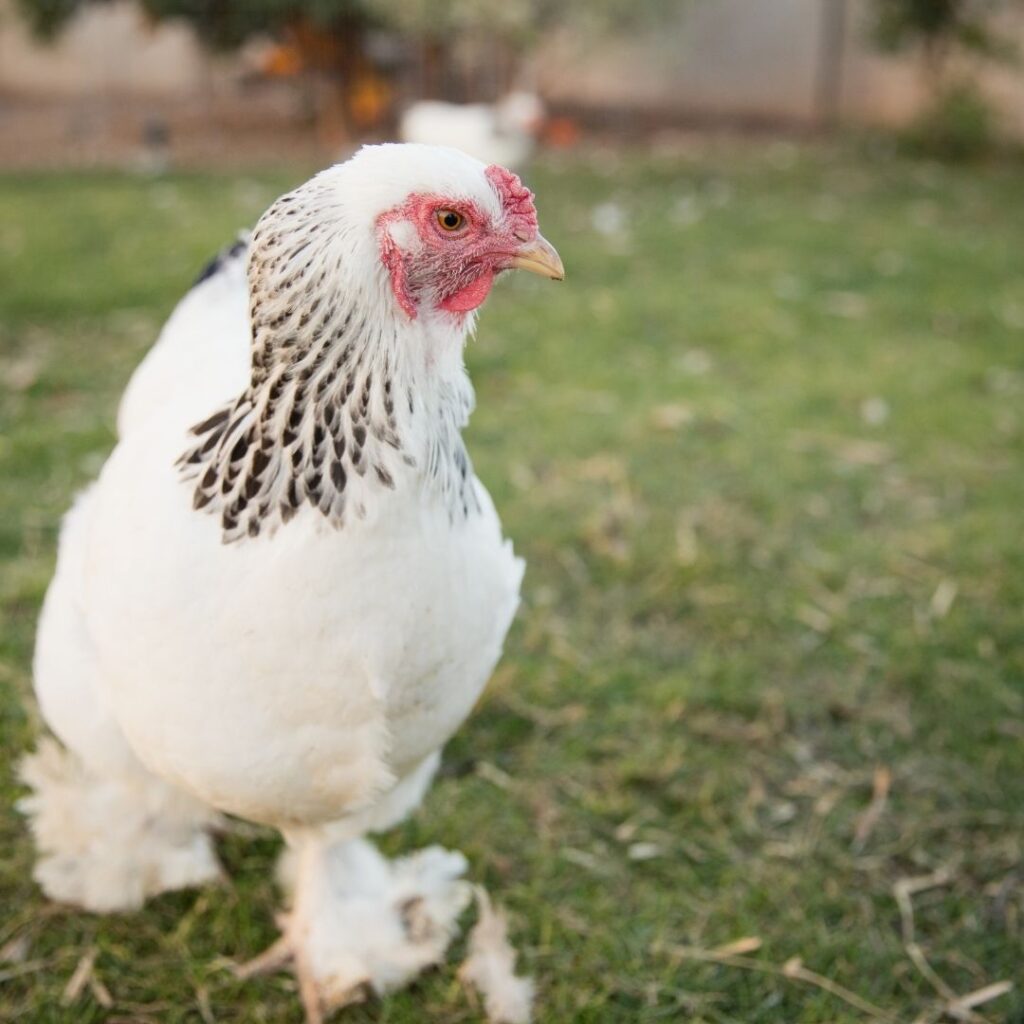
Brahma
This is considered an extra-large bird with hens weighing approximately 9.5 lbs. While they may be intimidating in size, Brahma chickens are pretty docile and sweet-natured. They are known to get along well with both human and other flock breeds, making them a great addition to a backyard farm.
Brahma chickens are cold-hardy birds that do well in cooler climates. However, they’re also relatively inactive, so they don’t require much space to roam around.
The first American Poultry Association Standard of Perfection in 1874 included both light and dark variants of the Brahma chicken, with the buff variant being added approximately 50 years later.
The Brahma remains a popular choice among poultry enthusiasts as a heritage breed. Despite their large size, these birds are also known for their productivity as meat and egg producers. The Brahma chicken is a distinctive breed that genuinely lives up to its title as the “King of All Poultry.”
Egg Size – Large
Egg Color – Brown
Eggs per year – 180-240

Easter Egger
Look no further than the Easter Egger chicken if you’re searching for a diverse, hardy flock and unique-looking eggs. They’re cold hardy, making them great for New Englanders like us, and heat hardy making them a great choice as one of the best-laying chickens for Texas farmsteads.
These birds are not actual breeds but rather a variety of breeds that one parent carries the blue egg gene. They come in various colors and conformations, and their eggs can vary significantly in shades of blue, green, olive, aqua, and even pink.
Easter Eggers are also known for being exceptionally friendly. All these qualities and more make these one of the best egg laying chickens for beginners.
Egg Size – Medium
Egg Color – blue to green to olive to aqua and even pinkish
Eggs per year – 200-280
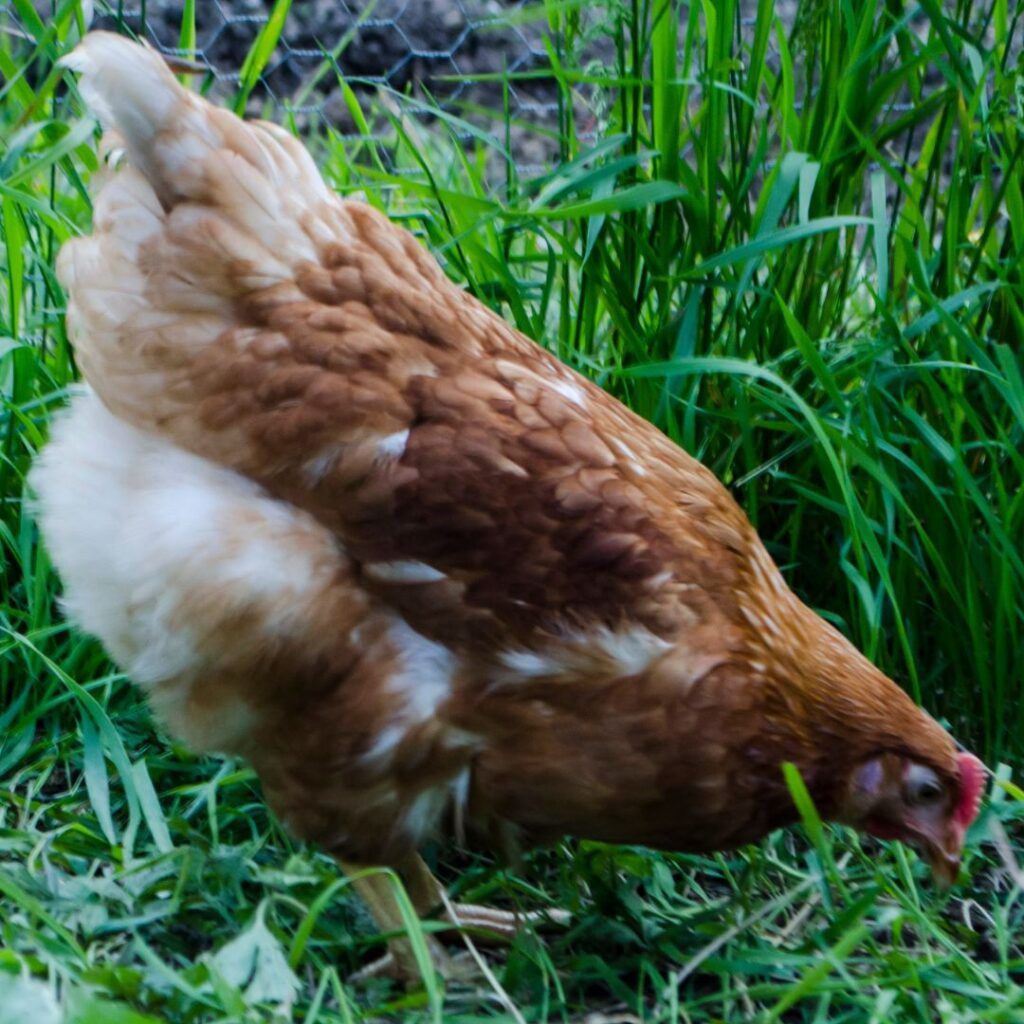
Golden Comet
For many reasons, the Golden Comet is a popular breed among backyard chicken enthusiasts. Not only do they have delightful personalities and stunning appearances, but they are also incredibly efficient egg layers.
These cold and heat-hardy chicken breeds are great for many areas with drastic weather fluctuations, like Texas and even the New England area.
These birds were initially bred by hatcheries for their sex-linked characteristics, allowing for male and female chicks to be separated at birth thanks to their different coloration. But Golden Comets, being hybrid chickens, also offer the added benefit of being hybrid vigor, meaning they often have better health and productivity than purebred chickens.
They are also known by several other names, such as Cinnamon Queen, Golden Buff, Red Star, or Gold Sex Link – all referring to their unique mottled golden coloration resulting from their parentage of a White Rock hen and New Hampshire rooster.
So whether you’re looking for birds with laid-back personalities or high egg production rates, the Golden Comet may be one of the best chicken breeds in your flock.
Egg Size – Large
Egg Color – Brown
Eggs per year – 250-320

Jersey Giants (Black Giants)
Created in New Jersey in the 1800s, this dual-purpose breed was designed for meat and egg production. The creation of the Jersey Giant involved crossing several other chicken breeds, including the Brahma, Cochin, and Langshan.
In addition to being great for farmers and homesteaders, Jersey Giants are also known for their friendly and gentle disposition. They are not as prone to bullying as other chicken breeds and make excellent pets, especially for children with children.
With hens weighing up to 11 pounds, these giants can also be quite impressive in size. This chicken also has the honor of being the largest chicken breed in the world. Currently, the American Poultry Association recognizes three accepted color varieties: original Black, White, and Blue. So whether you’re looking for a heavy producer or just a lovable backyard pet, the Jersey Giant may just be the perfect fit.
Egg Size – Large
Egg Color – Brown
Eggs per year – 180-260
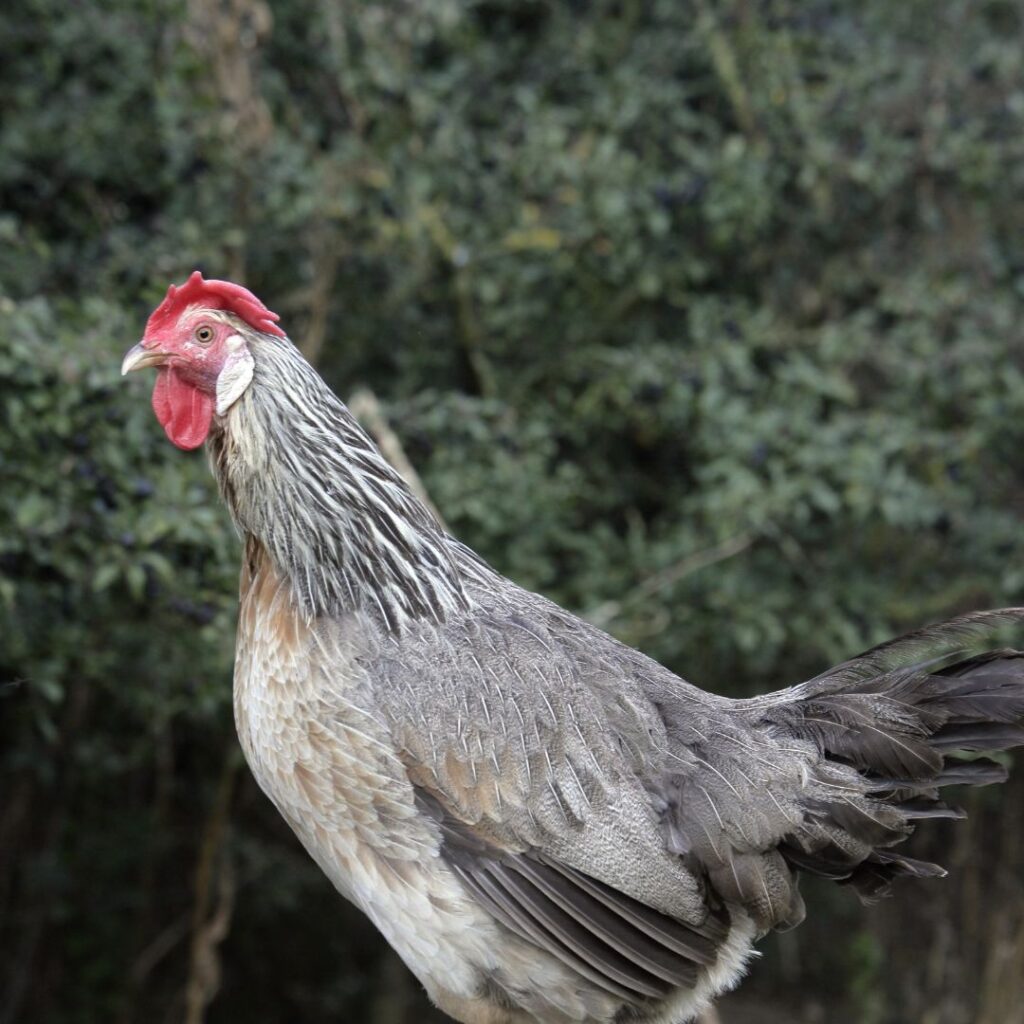
Leghorn
The Leghorn chicken is best known for its exceptional egg-laying abilities – hence the name “Leghorn,” which comes from a province in Italy where these chickens originated. They are also highly intelligent and active birds, preferring to forage for food rather than being confined to a coop.
They were brought to North America in the early 1800s and have since been recognized by the American Poultry Association as their distinct breed.
Leghorns come in various colors: black, brown, buff, silver duckwing, and pearl white.
And while they may not be the largest chickens around (with hens typically weighing in at only 5 pounds), they more than makeup for it with their high production of large eggs.
Their prowess as egg layers has led to them being crossed with other breeds to create even hardier chickens with alternative egg colors like The Rhode Island Reds and Cream Legbars.
Overall, the Leghorn chicken is an excellent choice if you’re looking for a dependable source of eggs from your backyard flock.
Egg Size – Large – X-Large
Egg Color – White
Eggs per year – 220-300
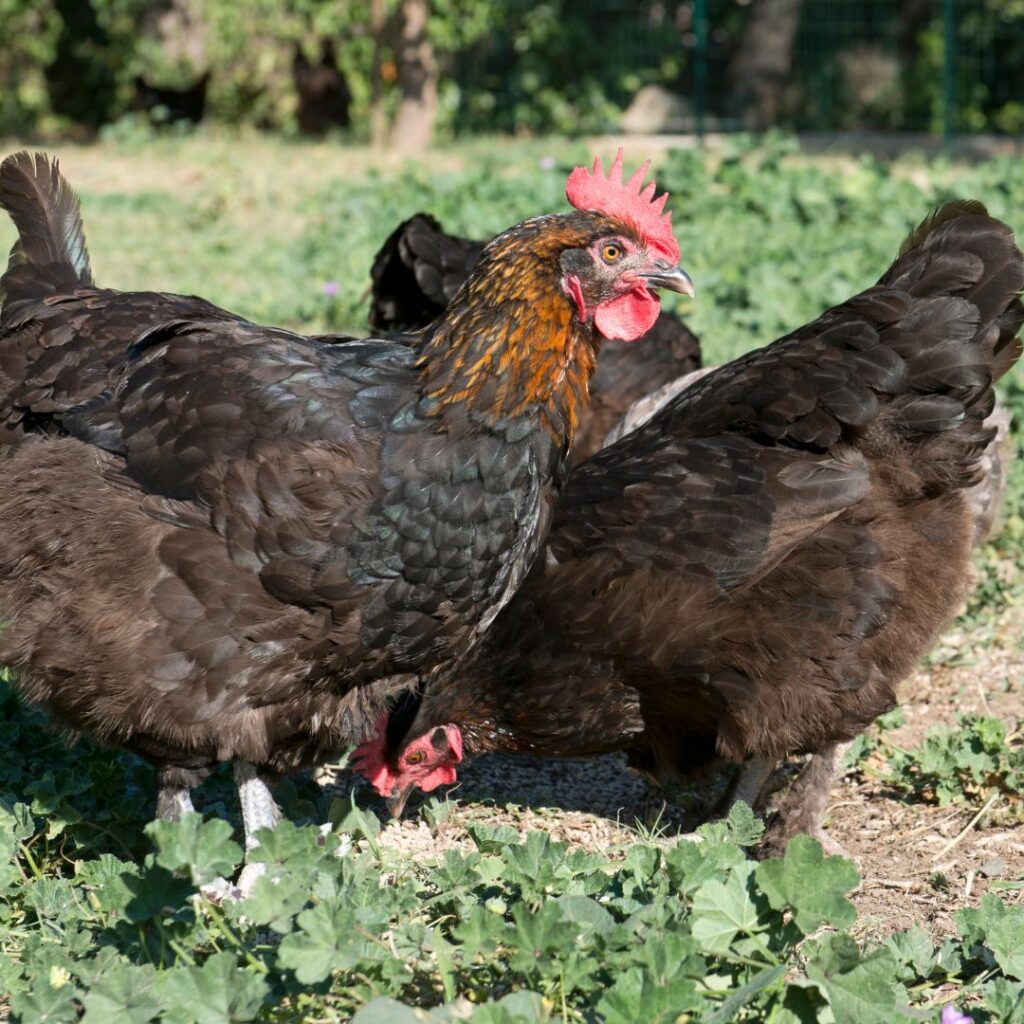
Marans
Marans chickens are a delight for their egg-laying abilities and friendly, docile dispositions. Originating in the town of Marans, France, these birds are well-known for their rich, dark chocolate brown eggs – often coveted by chefs and baked goods enthusiasts alike.
Marans were first brought to the U.S. in the early 1900s as ornamental birds, but it wasn’t until recently that they gained popularity as egg-laying machines. The American Poultry Association recognizes four varieties of Marans: Black, Black Copper, Wheaten, and White. The APA accepted this breed just recently, in 2020.
Though these chickens mature slowly and don’t typically begin laying until around eight months old, some owners have reported that hens can start laying eggs sooner if their nesting boxes are fully prepared by six months.
Females usually weigh 6-7 pounds and have a reputation for getting along well with their coop mates without bullying.
Whether raising them for their tasty eggs or simply enjoying them as backyard pets, Marans chickens are a breed worth considering adding to your flock.
Egg Size – Large
Egg Color – Dark (chocolate) Brown
Eggs per year – 200+
Note: Some U.S. hatcheries offer hybrid hens – Marans chicken breeds that lay over 250 dark brown eggs yearly.
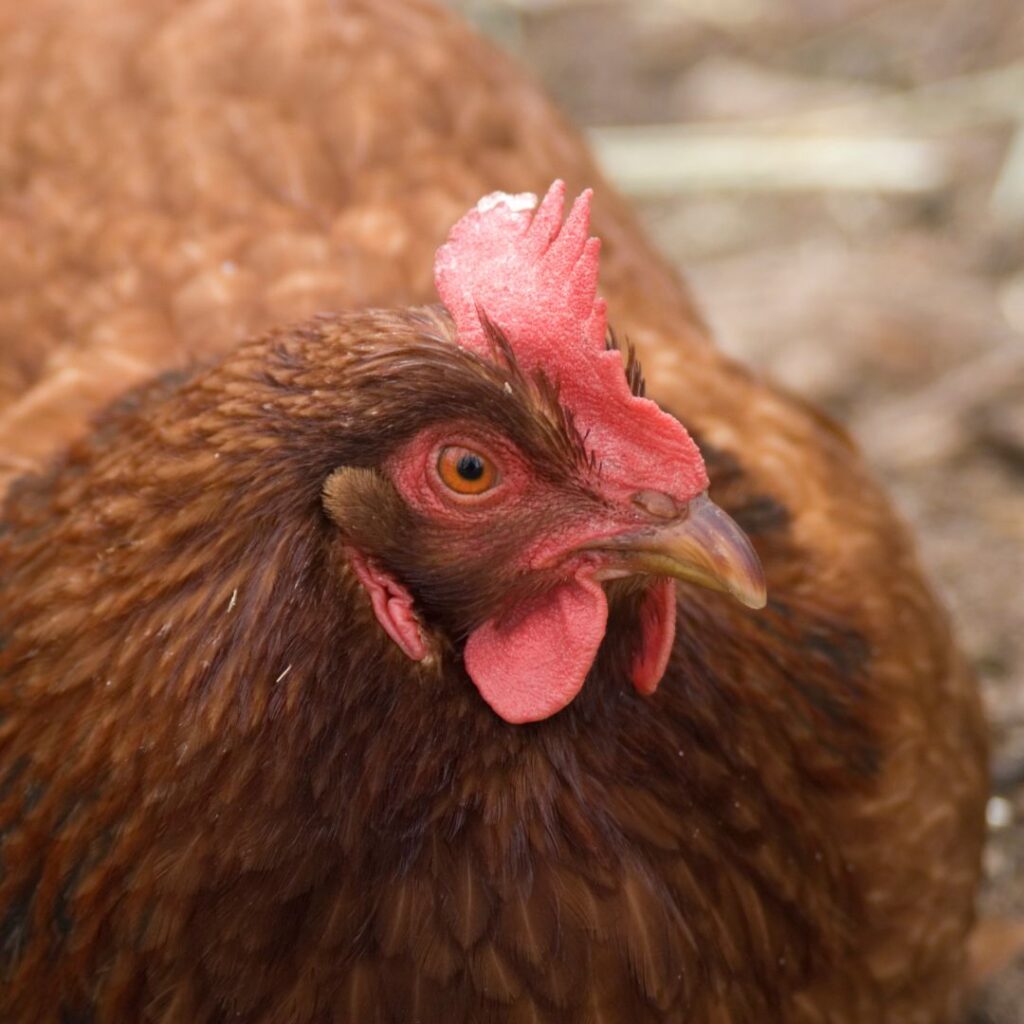
New Hampshire Red
The New Hampshire chicken is a beautiful and versatile breed, developed right here in the United States in 1915. The result of crossing a strain of Rhode Island Red chickens, the New Hampshire boasts fiery red and brown feathers and fast feather growth.
Not only are they visually attractive, but they are also an excellent choice for both egg and meat production. Their rapid growth and early maturation make them a popular option for those looking to raise chickens for their family use. I
n addition to their practical benefits, New Hampshire chicken is also known for being a gentle and easy-to-handle breed, making them an excellent choice for both experienced poultry farmers and those just starting.
The American Poultry Association even accepted this breed in 1935 as a heritage breed.
All in all, the New Hampshire chicken truly has it all – good looks and practicality combined. Our advice? Give this American-bred bird a try on your own farm!
Egg Size – Large-Extra Large
Egg Color – Brown
Eggs per year – 200-280
Niederrheiner
The Niederrheiner is a unique chicken breed with a rich history. Before World War II, this breed was developed in the Lower Rhine region of Germany using birds from the North Holland Blue chicken. Breeders carefully crossed other heavy and light breeds to create a bird that would excel in meat and egg production. In 1943, their hard work was recognized, and the Niederrheiner officially gained recognition.
Today, this versatile breed continues to thrive in various climates and fulfill its dual purpose of producing delicious meat and eggs.
If you’re searching for a friendly and reliable addition to your backyard poultry, the Niederrheiner chicken is an excellent choice. These birds are similar in appearance to their North Holland Blue ancestors but possess a key distinguishing feature: they have no feathering on their legs. Niederrheiner chickens also come in various beautiful colors, including crele, silver, lemon cuckoo, blue cuckoo, and birchen. In addition to their visually appealing features, these birds have laid-back personalities and seldom try to fly. However, they’re not known for being good mothers; hens rarely go broody and may need assistance to hatch and care for their chicks.
Overall, Niederrheiners are hardy birds with quality meat traits that make them valuable to any farm or backyard flock.
Egg Size – Medium
Egg Color – Cream – Light Brown
Eggs per year – 200+

Orpington
When selecting chicken breeds for a backyard flock, the Orpington is often at the top of many people’s lists. Of course, as one of the friendliest chicken breeds, this makes sense. These large, gorgeous birds are renowned for being docile and friendly, making them an excellent choice.
The Black Orpington breed was initially created from three different types of chickens. The Langshan, Barred Rock, and Minorca were all used to create the first Black Orpingtons. Buff Orpingtons were developed using Buff Cochins, Dorkings, and Gold-Spangled Hamburgs. Known for their fluffy feathers and gentle disposition, these large hens typically weigh around seven to eight pounds.
The American Poultry Association currently recognizes four standard colors – Black, Blue, Buff, and White. Each of these color varieties boasts stunning plumage and strong body conformation. There is also a lavender Orpington known to some as the purple chicken breed. This Purple chicken is quite stunning.
The Orpington was accepted into the APA in 1902.
In addition to their friendly disposition, Orpingtons are also considered good layers. It’s not hard to see why this heritage breed remains a favorite among chicken enthusiasts.
Egg Size – Large
Egg Color – Brown
Eggs per year – 200-280
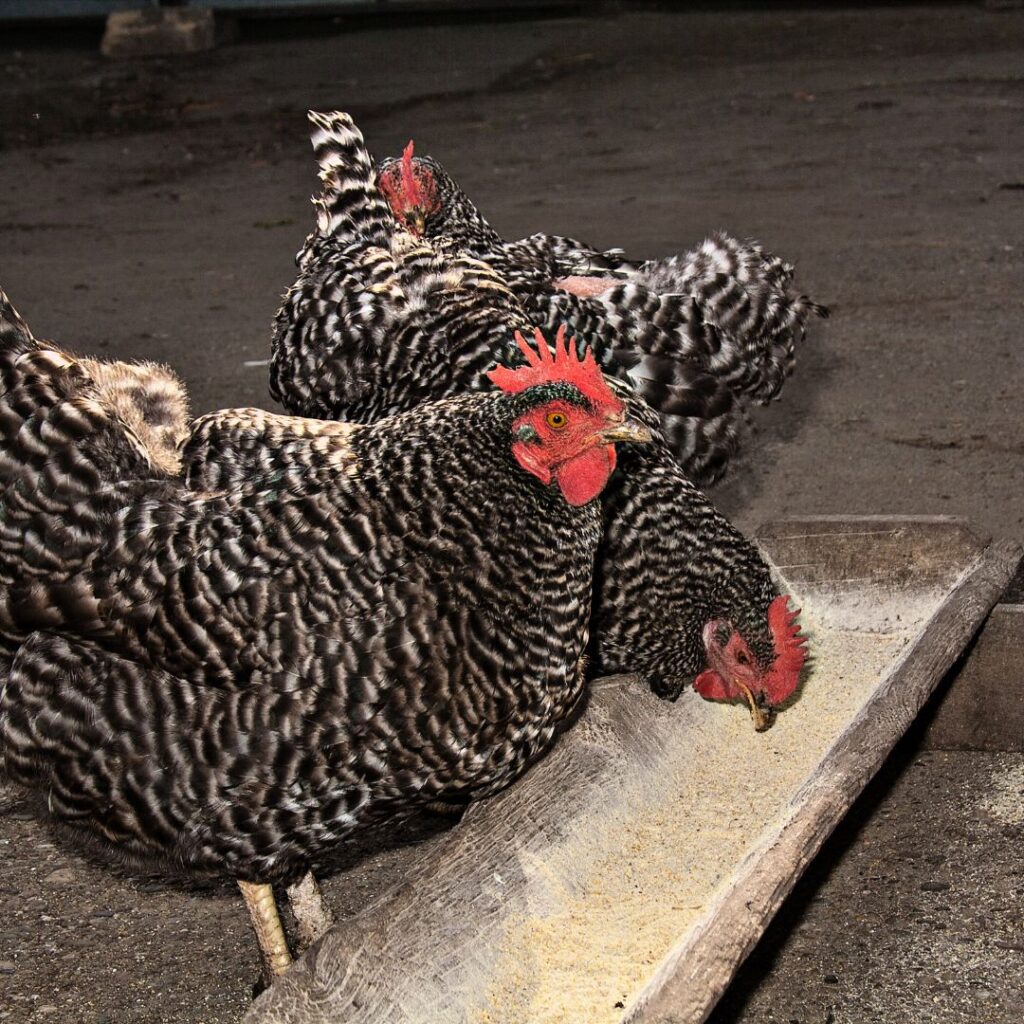
Plymouth Barred Rock
If you’re looking for a dependable dual-purpose breed, you can’t go wrong with the Plymouth Rock. The Plymouth Rock chicken is a true American original, with roots dating back to 1849, making them one of the oldest breeds in the United States.
This breed was accepted into the American Poultry Association in 1908. Seven recognized varieties – Barred, Blue, Buff, Colombian, Partridge, Silver Penciled, and White- will catch your eye with their gorgeous feather patterns.
The standard-sized Plymouth Rock hen weighs in at a hefty 7½ pounds.
These birds have a sweet, docile personalities and are known for their hardiness and dependability in terms of both egg production and meat yield.
Known for their inquisitive nature, Plymouth Rocks love to explore their surroundings and search for tasty treats. They do well in free-range and confined environments.
Plymouth Rock’s rich history, versatile traits, and charming demeanor make it a popular choice for backyard flocks and commercial farms.
Egg Size – Medium
Egg Color – Brown
Eggs per year – 200 – 280
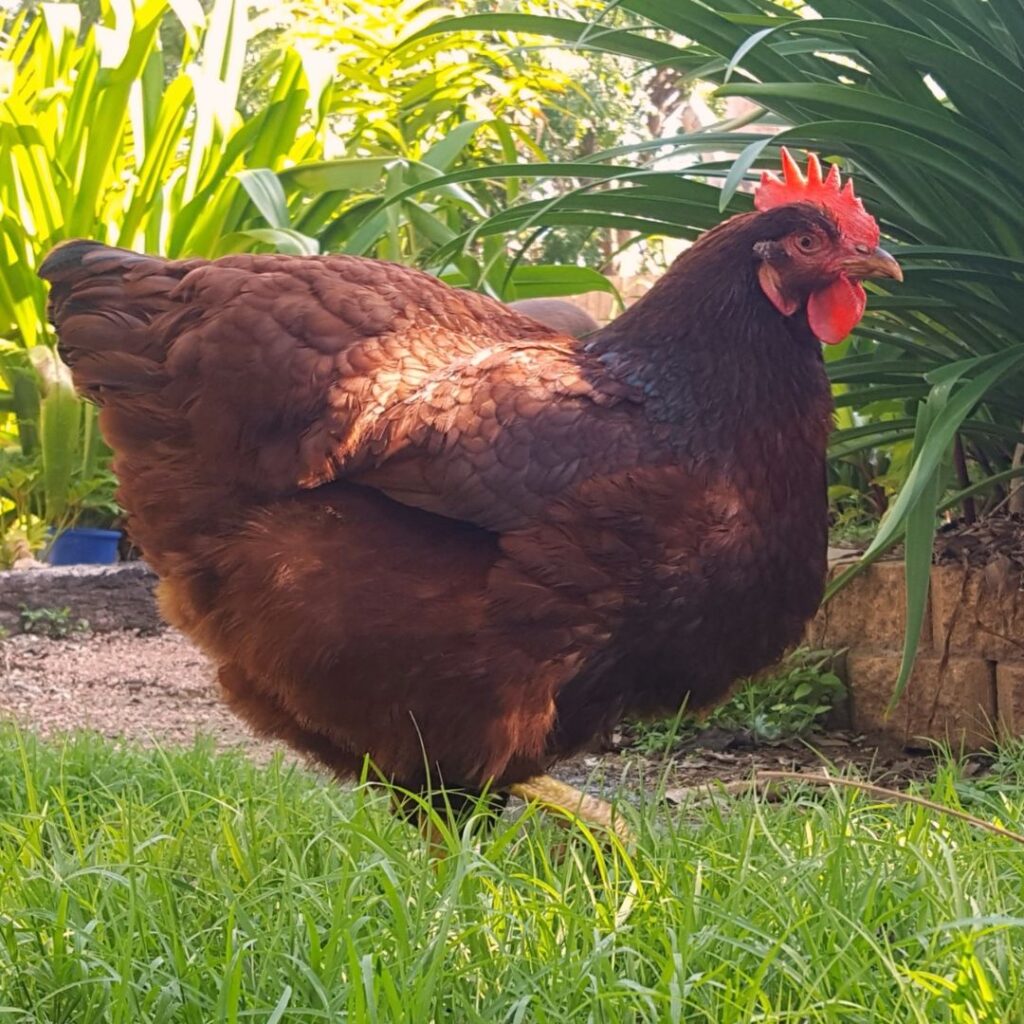
Rhode Island Red
The Rhode Island Red is a popular chicken breed for a good reason. Known for their hardiness and superb egg-laying ability, these birds can thrive in the backyard and in commercial flocks.
Originating in Rhode Island and first introduced to the public in 1874, this breed was developed as a cross between the Malay and Shanghais chicken breeds.
The result is a large bird, with hens weighing 6-7 pounds and a rich mahogany red feathering with occasional white on their underparts.
While they tend to be docile within their own breed, they may assert themselves as higher in the pecking order among other breeds. They also do well in free-range conditions and are known for their meat production and eggs.
Overall, it’s easy to see why the Rhode Island Red has been such a successful breed for over 150 years.
Egg Size – Large
Egg Color – Brown
Eggs per year – 200 – 280

Sussex
As a beloved British breed, the Sussex chicken is known for its versatility as both a good layer and a tasty source of meat. They are capable of laying even in harsh winter weather.
In short, the Sussex chicken offers the perfect combination of beauty, productivity, and hardiness for any poultry enthusiast.
With three distinct varieties Accepted into the American Poultry Association in 1914 – red, speckled, and (1929) light – this chicken adds diversity to any backyard flock.
Their calm demeanor and friendliness make them easy to handle, while their tendency to forage means they can help with pest control in the garden.
So next time you choose backyard chickens for your flock, consider the reliable and beloved Sussex chicken.
Egg Size – Large
Egg Color – Brown
Eggs per year – 180-240
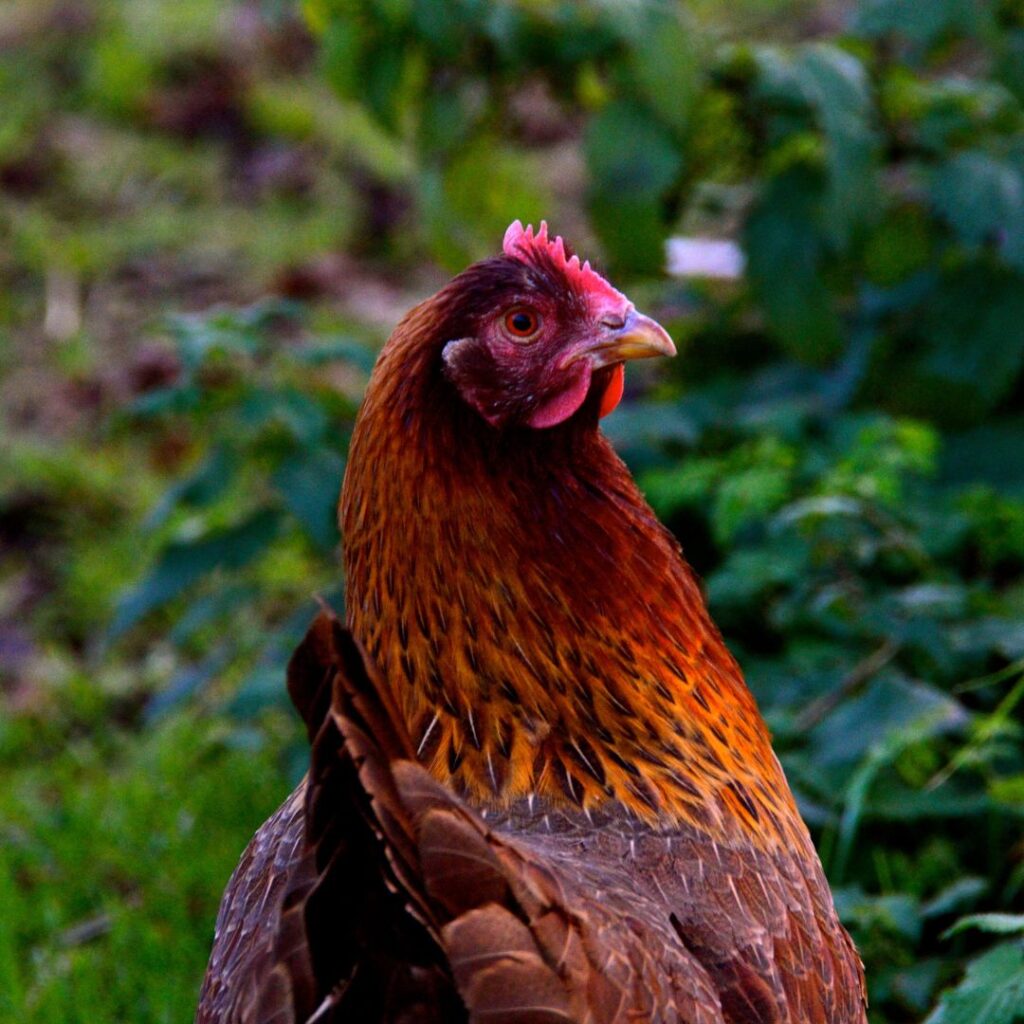
Welsummer
The Welsummer is a distinctive breed of chicken with its stippled reddish-brown feathers and pea comb. This Dutch breed is known for its good production of dark brown eggs and its friendly, docile temperament.
However, they are also a dual-purpose breed known for their meat and eggs. The Welsummer is also known to be a cold hardy breed.
These are a heritage breed. Only one type of Welsummer is accepted by the APA in America, which is the Partridge variety. They were accepted in 1991.
The Welsummer makes a great addition to most flocks, as they are not aggressive towards other breeds and tend to have a stable position in the pecking order.
Fun facts:
Prince Charles keeps them as backyard pets. Another fun fact for all you cereal enthusiasts out there – the Welsummer rooster inspires Kellogg’s rooster logo!
The Welsummer is a unique and valuable breed for backyard poultry keepers and commercial egg farms.
Egg Size – Medium
Egg Color – Dark “reddish” Brown
Eggs per year – 200-280
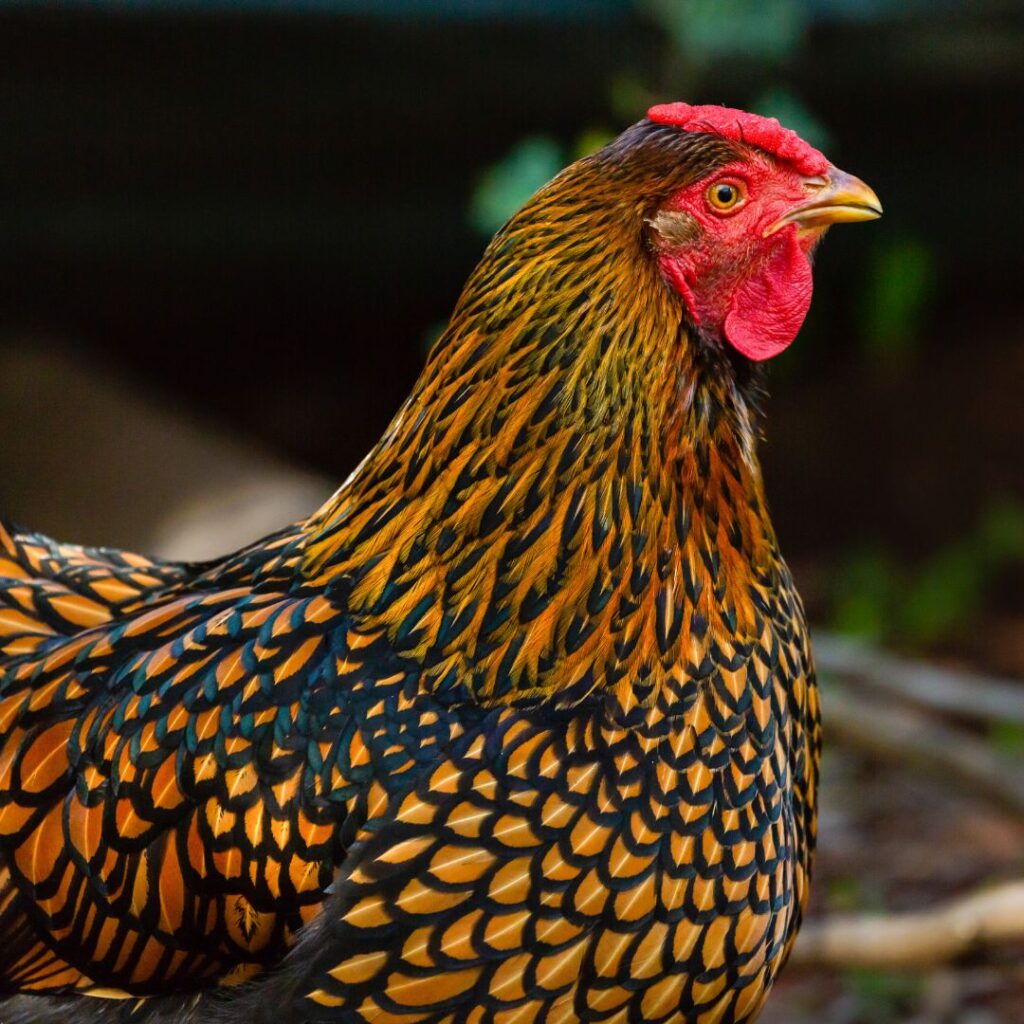
Wyandottes
If you’re looking for an all-around dependable chicken breed, look no further than the Wyandotte. Initially developed in the northeastern U.S., they have become a fan favorite among homesteaders due to their consistent egg production and meatiness.
The Wyandotte is usually at the top of their flock’s pecking order. Though they may be a bit aloof from other breeds, Wyandottes do well with confined spaces as long as they have adequate space. However, they prefer even room to roam and are great foragers when set to free range.
These large birds have beautiful feathers. Luckily there are many color variations to admire and choose from – silver laced, gold laced, black, buff, blue, and more – these chickens make a gorgeous addition to any backyard poultry family.
The Wyandotte first made its debut in the American Poultry Association in 1883 (variations followed over the 90 years following), and it’s clear that this breed has stood the test of time.
If you’re looking for a reliable option for eggs and meat, consider adding some Wyandottes to your flock.
Egg Size – Large
Egg Color – Brown
Eggs per year – 200+
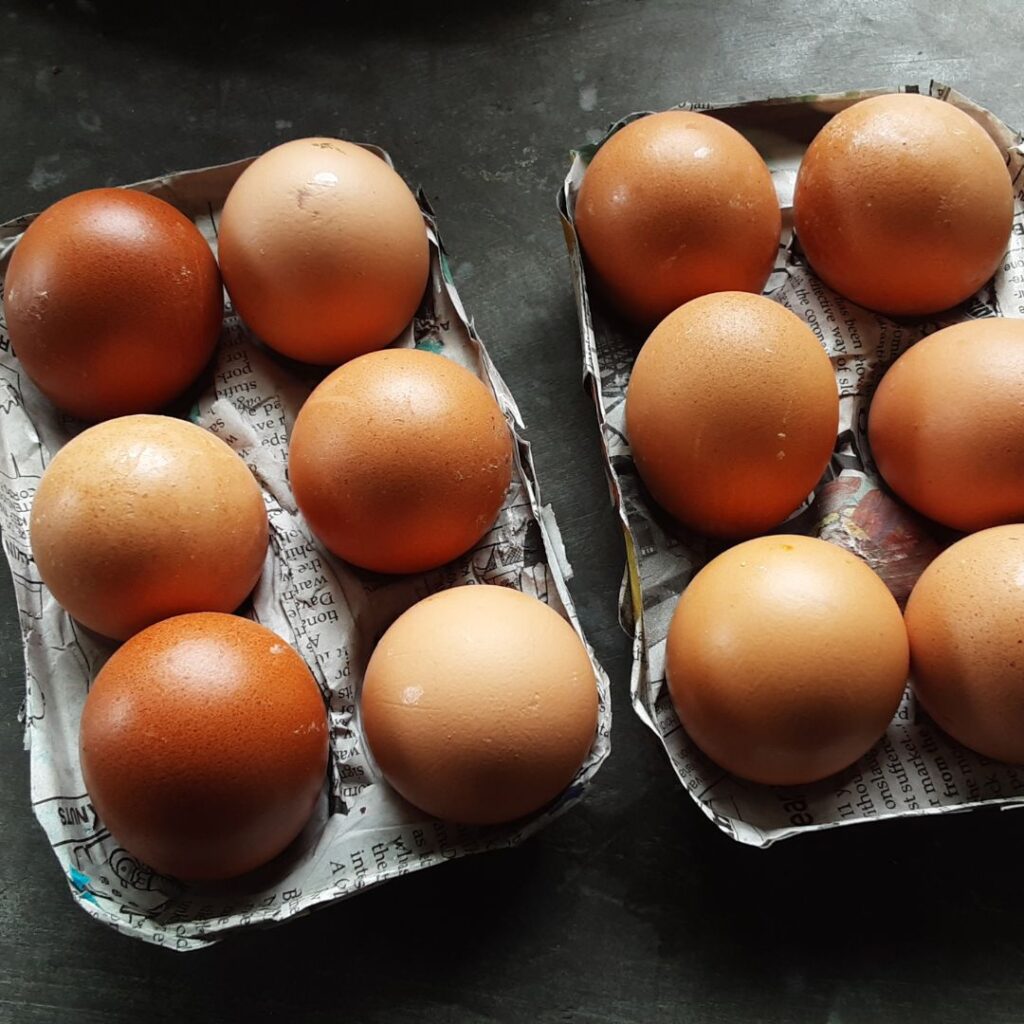
Popular Chicken Breeds Used In Commercial Egg Production
Most Brown Eggs on commercial market shelves are from Rhode Island Reds, Barred Plymouth Rocks, Buff Orpingtons, and hybrid brown egg-laying chickens.
White Eggs primarily are from the White Leghorns.
With the pandemic came supply chain problems, so more and more commercial markets started stocking shelves with more local varieties than they used to. Don’t be surprised to find a variety of brown and white egg-laying chicken contributing to your shopping cart.
Read about chickens laying eggs in the winter (year-round) here.
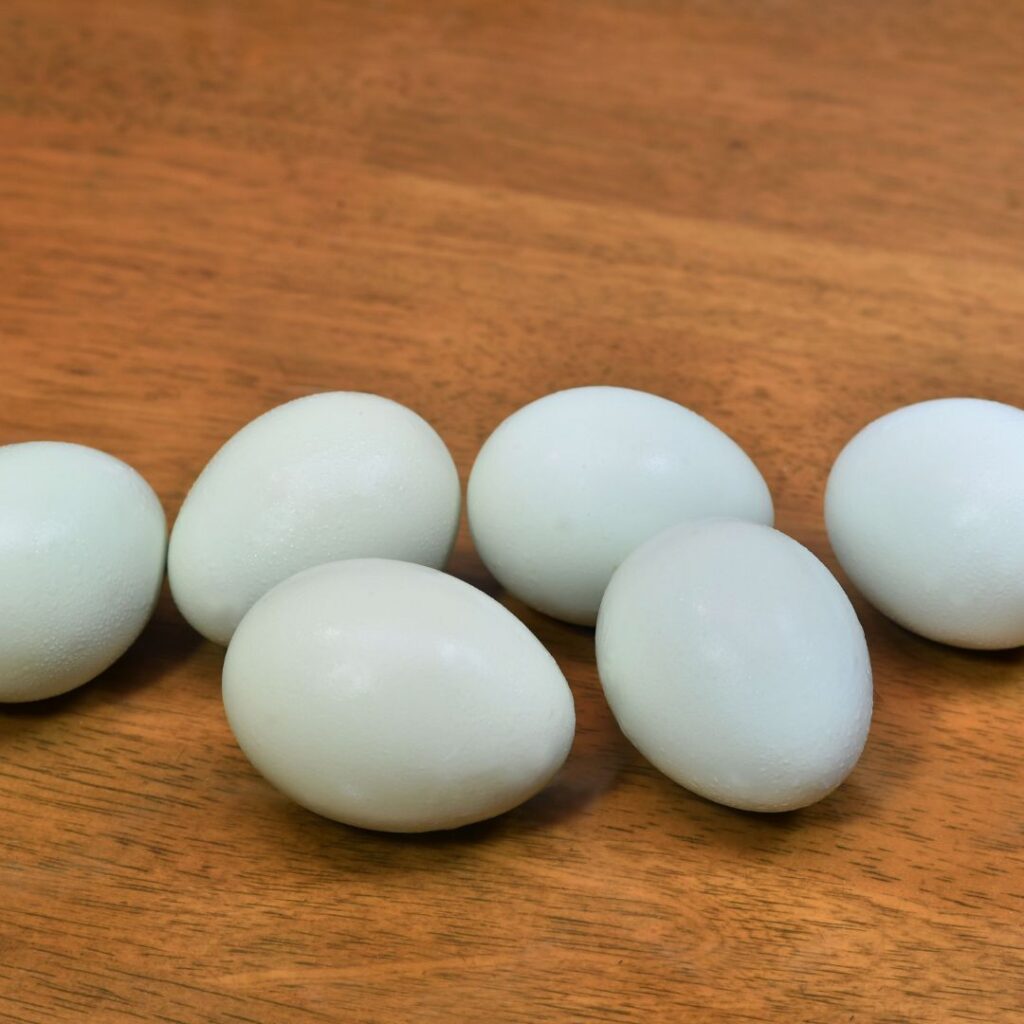
6 Chickens that lay blue eggs
Ever wondered why some eggs are blue and others are brown? The answer lies in the breed of the chicken laying them. While a chicken’s diet can affect its egg’s quality and overall nutritional content, it does not change its color.
Chickens who lay blue eggs have a unique pigment called oocyanin, which creates their distinctive coloration inside and outside the shell. This differs from the pigment that gives brown eggs their hue.
So next time you see a carton of blue eggs at your local farmer’s market, know that they didn’t come from some magical chicken that is eating special food – they were just laid by one with a particularly vibrant breed!
And as a fun fact – it has been proven that there is no difference in taste or nutrient content between blue and brown eggs. So grab whichever catches your eye and enjoy!
Six hens that lay blue eggs:
- Araucana
- Ameraucana
- Arkansas Blue
- Easter egger
- Legbar
- Whiting True Blue
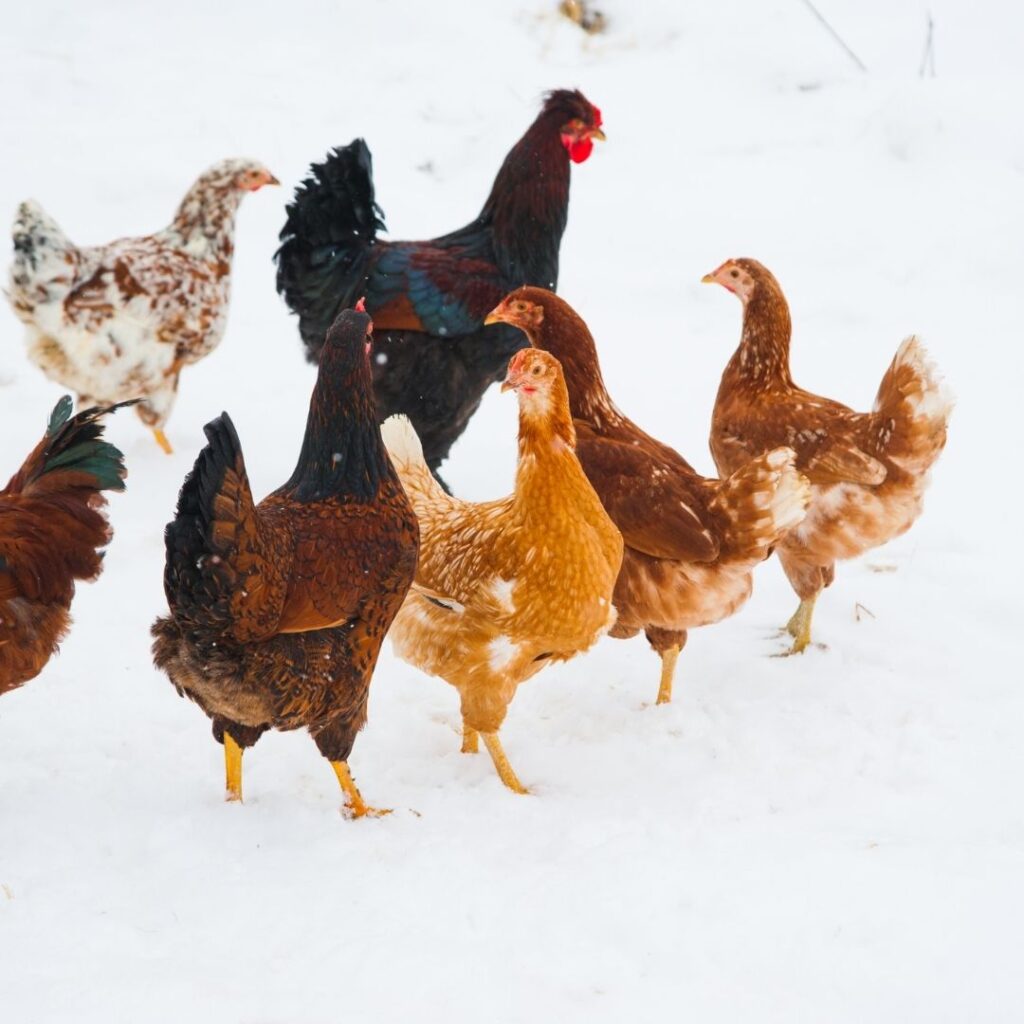
18 Best Cold Hardy Chicken Breeds that lay lots of eggs
Are you looking to have fresh eggs year-round in your cold climate backyard chicken coop? Then consider investing in a cold-hardy breed of chickens. These resilient birds have smaller wattles and combs, helping them withstand frostbite, and are full-feathered to keep warm in chilly temperatures. They also tend to be bigger and more muscular, with higher body fat for added warmth. You can read all about winter chicken care here.
Cold-hardy breeds may not always be as visually appealing as other breeds, but they more than make up for it with their hardiness and ability to thrive in colder climates.
These tough chickens often excel at meat and egg production, making them a versatile choice for any backyard flock. So if you want to enjoy farm-fresh eggs throughout the year, look into adding some cold-hardy chickens to your coop.
Our top eighteen winter hardy chickens :
- Ameraucana
- Australorp
- Brahma
- Buckeye (best egg laying chickens for Ohio and other northern states)
- Chantecler
- Cochin (Buff Cochin)
- Delaware
- Dominique
- Easter Eggers
- Jersey Giant
- New Hampshire Red
- Olive Egger
- Orpington (Buff)
- Rhode Island Red
- Speckled Sussex
- Silkie
- Welsummer
- White Leghorn
See below video for a chicken color breeding chart.
Can A Good Chicken Coop Help with Egg Production?
When raising backyard chickens, having a good chicken coop is vital. Not only does it provide a safe and secure space for your feathered friends, but it can also significantly impact egg-laying. Happy chickens are more likely to lay eggs consistently, so provide appropriate nesting boxes and enough room for them to move around comfortably. Clean bedding materials and proper ventilation also contribute to a happy chicken coop, increasing egg production. So, although having a chicken coop may seem like just another chore on your list of tasks, it can benefit you and your chickens in the long run. Remember, a happy chicken coop = more eggs.

It can be overwhelming starting out if you are a first-time chicken keeper, it doesn’t need to be. Be sure to read all our tips on starting out with backyard chickens.
Reasons Why Chickens Stop Laying Eggs
Whether raising chickens as pets or for their delicious eggs, there may come a time when your feathered friends stop laying. This can be frustrating, but it’s important to remember that it’s a natural and common occurrence.
Sometimes, simply adjusting the light they receive or reducing stress can boost production. However, poor nutrition can also cause a decline in egg-laying. Are you offering enough quality protein in their feed? Are they getting ample access to clean water? Don’t forget about treats – even something as simple as kitchen scraps can provide critical nutrients for your chickens.
The molting season can also temporarily halt egg production as chickens shed old feathers and grow new ones. To help them through this process, make sure they have plenty of high-protein food and calcium supplements available.
Some hens may also become “broody,” which means they want to sit on a nest to hatch eggs rather than lay them regularly. While some chicken owners encourage brooding, others prefer to discourage it so their flock continues producing eggs. Read more about broody chicken breeds here.
Finally, bear in mind that chickens typically have a lifespan of around 8-10 years, and it’s normal for egg production to decline with age.
All these factors can help ensure your flock remains happy and productive for years.
What Chickens Start Laying Eggs The Fastest?
If you’re a chicken owner, you might be eager for your hens to start laying eggs. While the average age for egg production (hen maturity) is around 20 weeks old, some breeds are known to start earlier.
Varieties like Leghorns, Golden Comets, Black Sex Links, Rhode Island Reds, and Australorps have been bred specifically for their egg-laying abilities and may begin as early as 17 or 18 weeks old.
But how can you tell when your hen is gearing up to lay her first eggs? Look out for enlarged and reddening combs and wattles, increased vocalization, and a heightened interest in the nesting area. Your chicken may also have an increased appetite or display a submissive squat when approached by other chickens or humans.
With these indicators in mind, you can anticipate the arrival of your hen’s first eggs with excitement and anticipation!
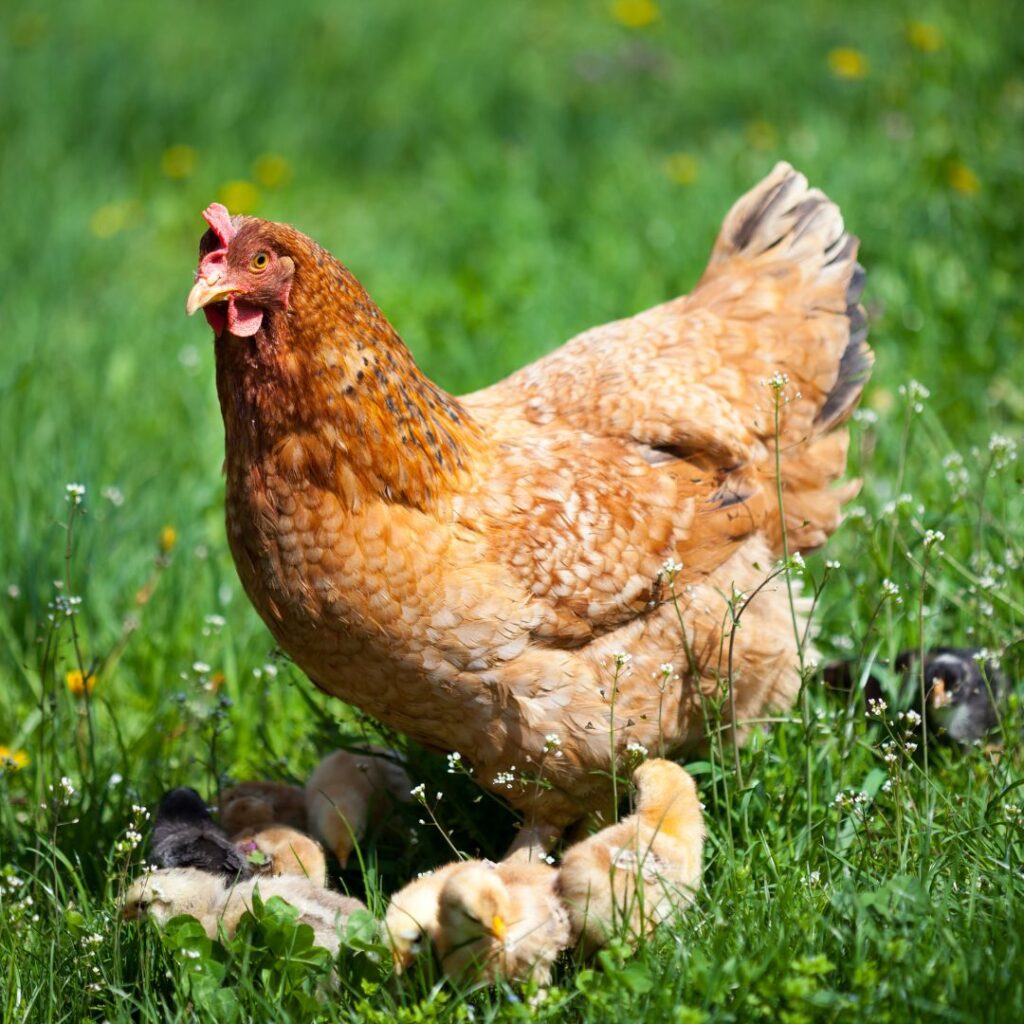
8 Breeds that lay large – extra large eggs
- Barred Rock
- Jersey Giants
- Langshan
- Leghorn
- New Hampshire Reds
- Orpingtons
- Rhode Island Red
- Welsummer
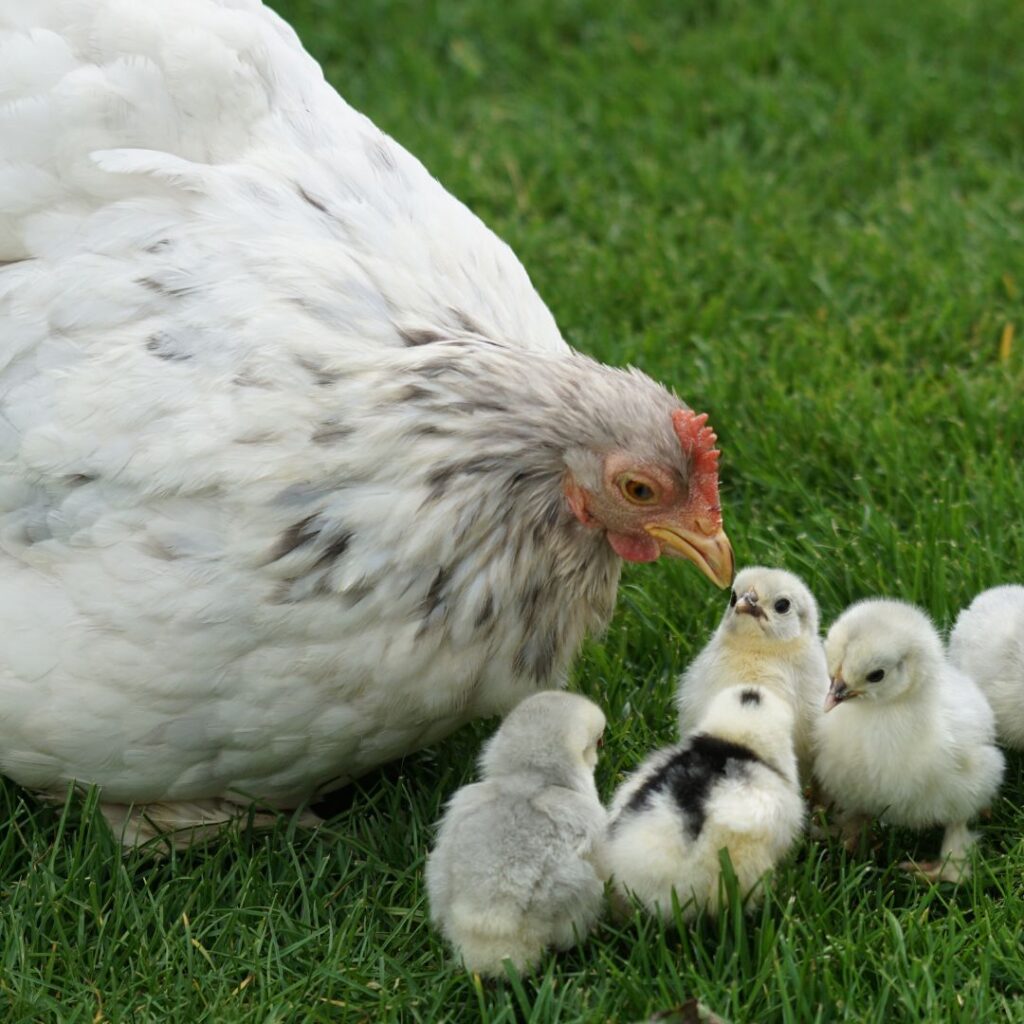
10 Best Egg-Laying Chickens For Families (Pets)
Chickens have always been a popular choice for backyard flocks, but more and more children are discovering the joys of raising backyard chickens from the moment they hatch. Watching baby chicks grow into beautiful, flourishing chickens isn’t just exciting – it also teaches important life lessons.
Kids learn responsibility as they care for their flock, values like hard work and respect, and even where their food comes from. And with the potential to sell eggs or chickens, children can also learn about finance and entrepreneurship. Raising chickens is a fun, and educational experience for kids of all ages, and the benefits will stick with them throughout their lives.
Ten of Our Favorites for Raising Chickens for Pets are Here:
Buff Orpingtons
Lavender Orpingtons
Australorps
Ameraucanas
Barred Plymouth Rocks
Silkie Bantams
Cochins
Brahma Chickens
Polish Chickens
Our Apologies, we were forgetting to add one of the most popular and all-time favorites of children, the Easter Eggers!
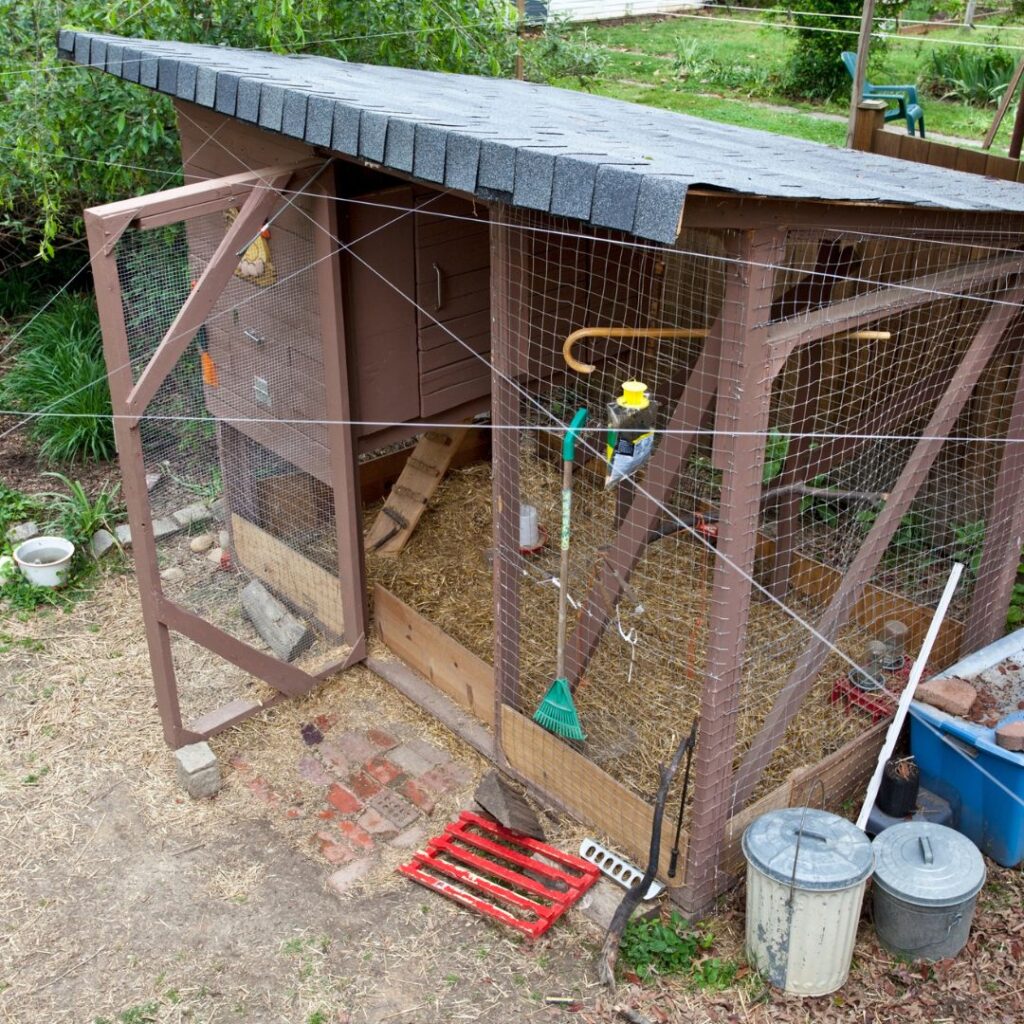
10 Best Egg-Laying Chickens for Urban (City) Settings
Raising city chickens is becoming a popular trend for urban dwellers who want to have fresh eggs and even meat on their dinner tables. (note: this article assumes you have already checked on your local laws regarding keeping chickens)
Before jumping into it, there are some important considerations to keep in mind. Firstly, ensure you have enough space for both the coop and run. Chickens need room to roam and exercise, so cramped quarters can lead to health problems.
Secondly, consider if your city allows roosters – they can be noisy and may not be allowed in residential areas.
Additionally, think about how you will dispose of chicken waste from the coop – it can attract pests if not properly taken care of.
Another factor to consider is whether or not the chickens will do well in a confined space. Some breeds are better suited for being able to free range rather than being restricted to a small run.
Finally, ensure that the chickens can handle your climate – some breeds do better in hot or cold weather than others. By considering all of these things, urban chicken ownership can be a rewarding experience for both you and your feathered friends.
Here are our top ten picks for city chicks
- Ameraucana
- Australorp
- Barred Plymouth Rock
- Brahma
- Cochin
- Marans
- Orpington
- Rhode Island Red
- Sussex
- Wyandotte
Maybe You Prefer A Bantam Breed like the Mille Fleur D’Uccle Or The Sebright Bantam?

Summary
With so many chicken breeds available, choosing the best chicken for your needs can be challenging. Consider what you need from your chicken to make the best decision for both of you. Do you want a chicken that lays lots of eggs? One that lays large eggs? Do you want a heritage chicken or one of the hybrid breeds, or one with unique-colored eggs? No matter what you’re looking for, there’s sure to be a chicken on this list that will fit the bill.




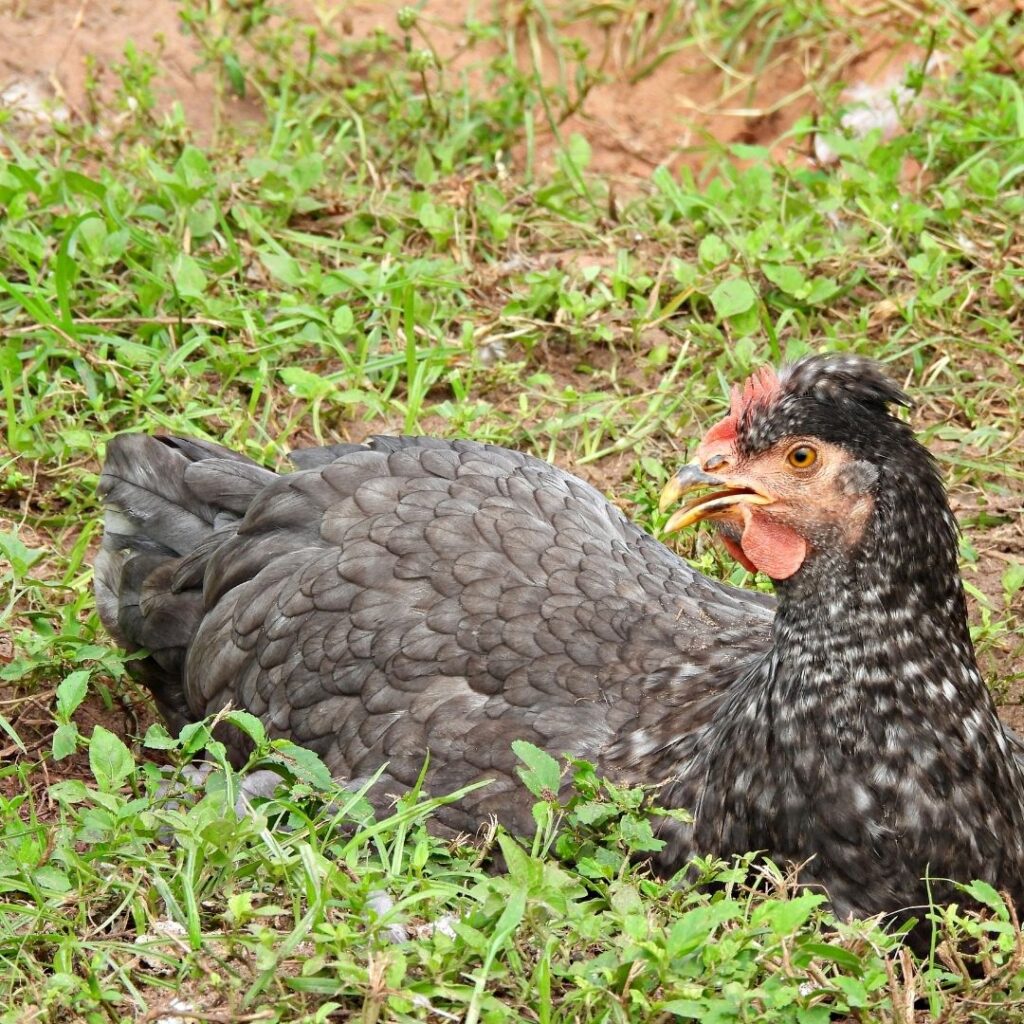
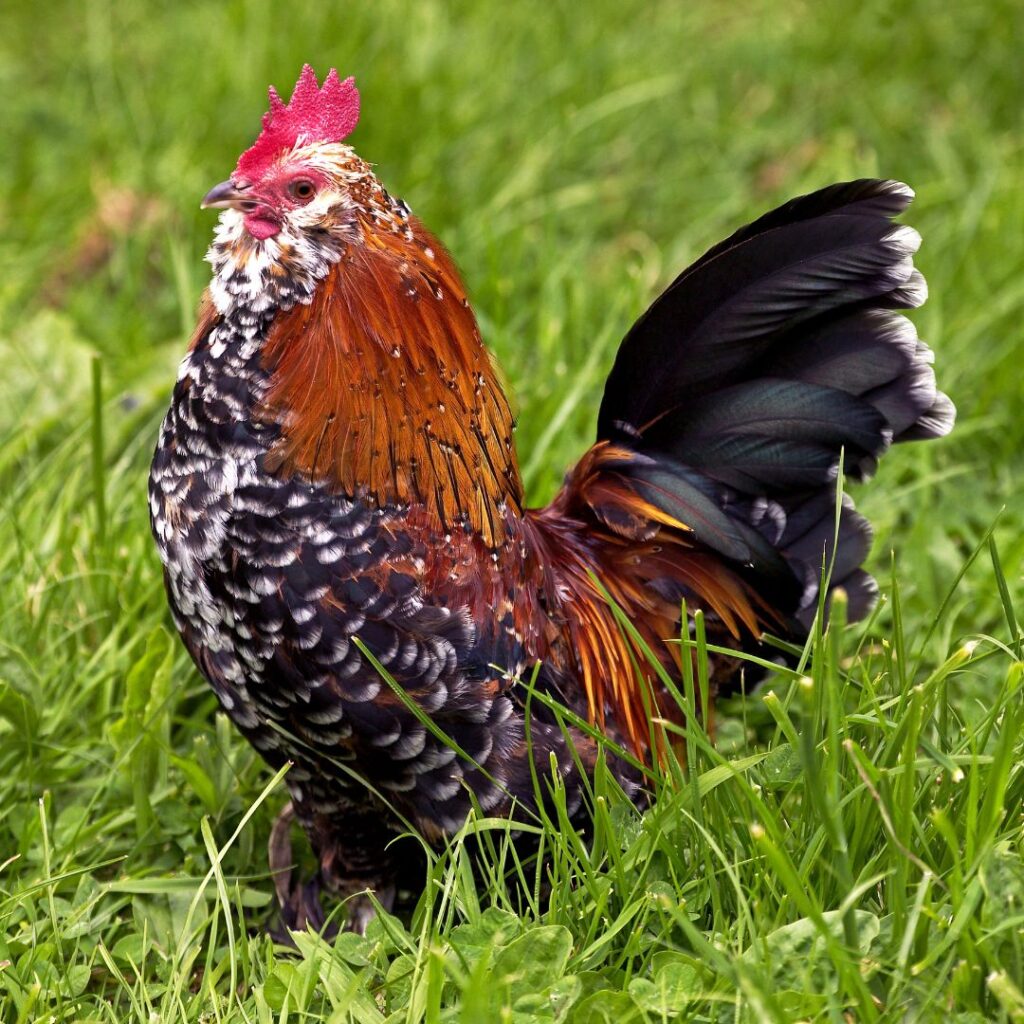
Pingback: Golden Laced Wyandotte Chicken; About The Wyandotte Chicken Breed